MGT583 Managing for Sustainability: Assessment 2 Solution Example
VerifiedAdded on 2023/03/21
|10
|2272
|34
Homework Assignment
AI Summary
This document presents a solution to MGT583 Assessment 2, focusing on managing for sustainability. It addresses threats and opportunities related to sustainability for companies like Zimmermann, including limited raw materials, labor disruptions, and changing consumer sentiment. The solution also explores public policy challenges, Interface's sustainability initiatives, and Fuji Xerox's sustainable operations. Furthermore, it examines ANZ's corporate responsibility report and the role of the Australian Greenhouse Calculator in reducing greenhouse gas production. Finally, it discusses the impact of supermarkets on public health and the importance of promoting healthy food choices. Desklib offers this document as a resource for students seeking help with their assignments and provides access to a wide range of study materials, including past papers and solved assignments.

MGT583 - Managing for Sustainability
Assessment 2
Student Name:
Student ID:
University Name:
1
Assessment 2
Student Name:
Student ID:
University Name:
1
Paraphrase This Document
Need a fresh take? Get an instant paraphrase of this document with our AI Paraphraser

Contents
Week 1........................................................................................................................................................2
Week 3........................................................................................................................................................4
Week 4........................................................................................................................................................5
Week 5........................................................................................................................................................6
Week 6........................................................................................................................................................7
Week 9........................................................................................................................................................8
Week 10......................................................................................................................................................9
Week 1
Threats relating to sustainability for Zimmermann
2
Week 1........................................................................................................................................................2
Week 3........................................................................................................................................................4
Week 4........................................................................................................................................................5
Week 5........................................................................................................................................................6
Week 6........................................................................................................................................................7
Week 9........................................................................................................................................................8
Week 10......................................................................................................................................................9
Week 1
Threats relating to sustainability for Zimmermann
2
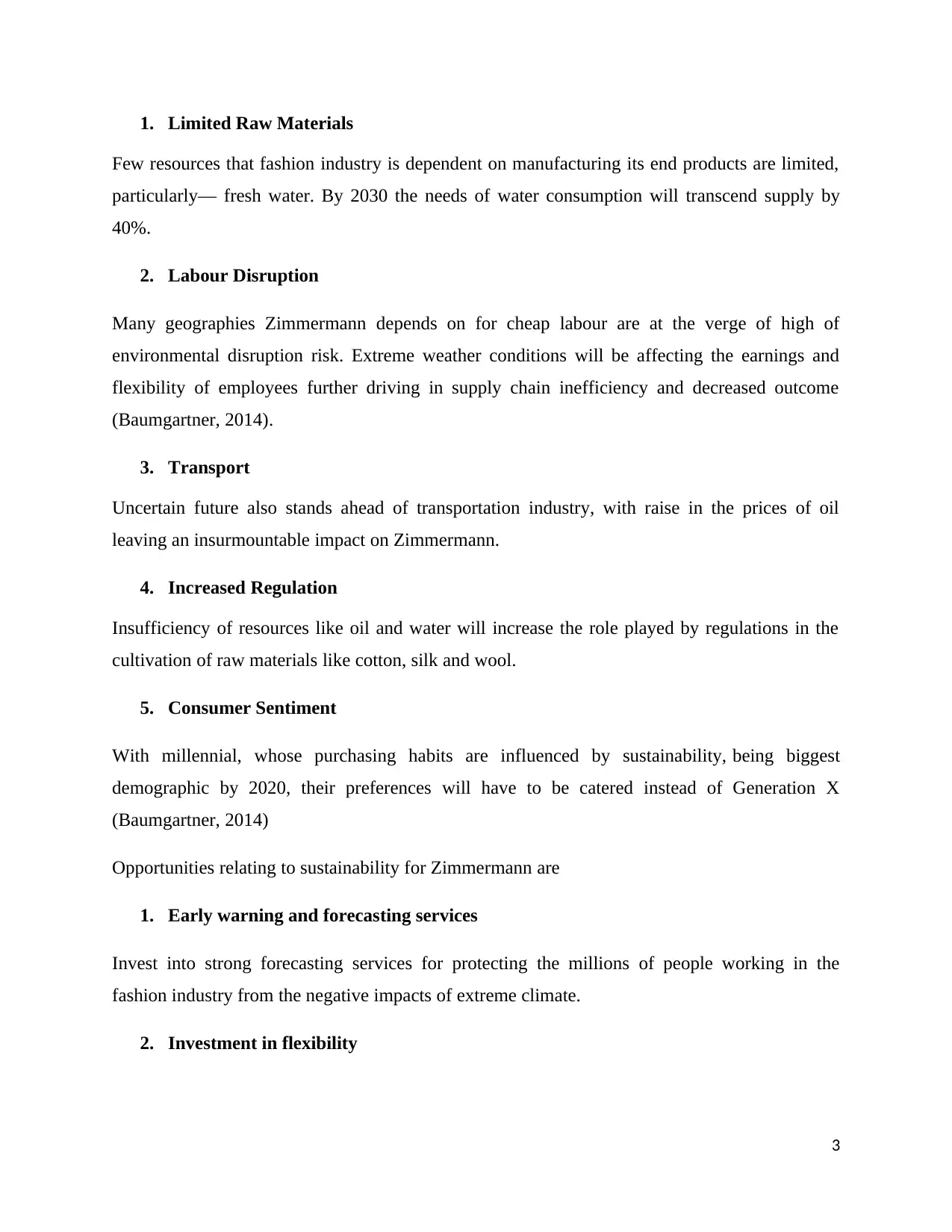
1. Limited Raw Materials
Few resources that fashion industry is dependent on manufacturing its end products are limited,
particularly— fresh water. By 2030 the needs of water consumption will transcend supply by
40%.
2. Labour Disruption
Many geographies Zimmermann depends on for cheap labour are at the verge of high of
environmental disruption risk. Extreme weather conditions will be affecting the earnings and
flexibility of employees further driving in supply chain inefficiency and decreased outcome
(Baumgartner, 2014).
3. Transport
Uncertain future also stands ahead of transportation industry, with raise in the prices of oil
leaving an insurmountable impact on Zimmermann.
4. Increased Regulation
Insufficiency of resources like oil and water will increase the role played by regulations in the
cultivation of raw materials like cotton, silk and wool.
5. Consumer Sentiment
With millennial, whose purchasing habits are influenced by sustainability, being biggest
demographic by 2020, their preferences will have to be catered instead of Generation X
(Baumgartner, 2014)
Opportunities relating to sustainability for Zimmermann are
1. Early warning and forecasting services
Invest into strong forecasting services for protecting the millions of people working in the
fashion industry from the negative impacts of extreme climate.
2. Investment in flexibility
3
Few resources that fashion industry is dependent on manufacturing its end products are limited,
particularly— fresh water. By 2030 the needs of water consumption will transcend supply by
40%.
2. Labour Disruption
Many geographies Zimmermann depends on for cheap labour are at the verge of high of
environmental disruption risk. Extreme weather conditions will be affecting the earnings and
flexibility of employees further driving in supply chain inefficiency and decreased outcome
(Baumgartner, 2014).
3. Transport
Uncertain future also stands ahead of transportation industry, with raise in the prices of oil
leaving an insurmountable impact on Zimmermann.
4. Increased Regulation
Insufficiency of resources like oil and water will increase the role played by regulations in the
cultivation of raw materials like cotton, silk and wool.
5. Consumer Sentiment
With millennial, whose purchasing habits are influenced by sustainability, being biggest
demographic by 2020, their preferences will have to be catered instead of Generation X
(Baumgartner, 2014)
Opportunities relating to sustainability for Zimmermann are
1. Early warning and forecasting services
Invest into strong forecasting services for protecting the millions of people working in the
fashion industry from the negative impacts of extreme climate.
2. Investment in flexibility
3
⊘ This is a preview!⊘
Do you want full access?
Subscribe today to unlock all pages.

Trusted by 1+ million students worldwide
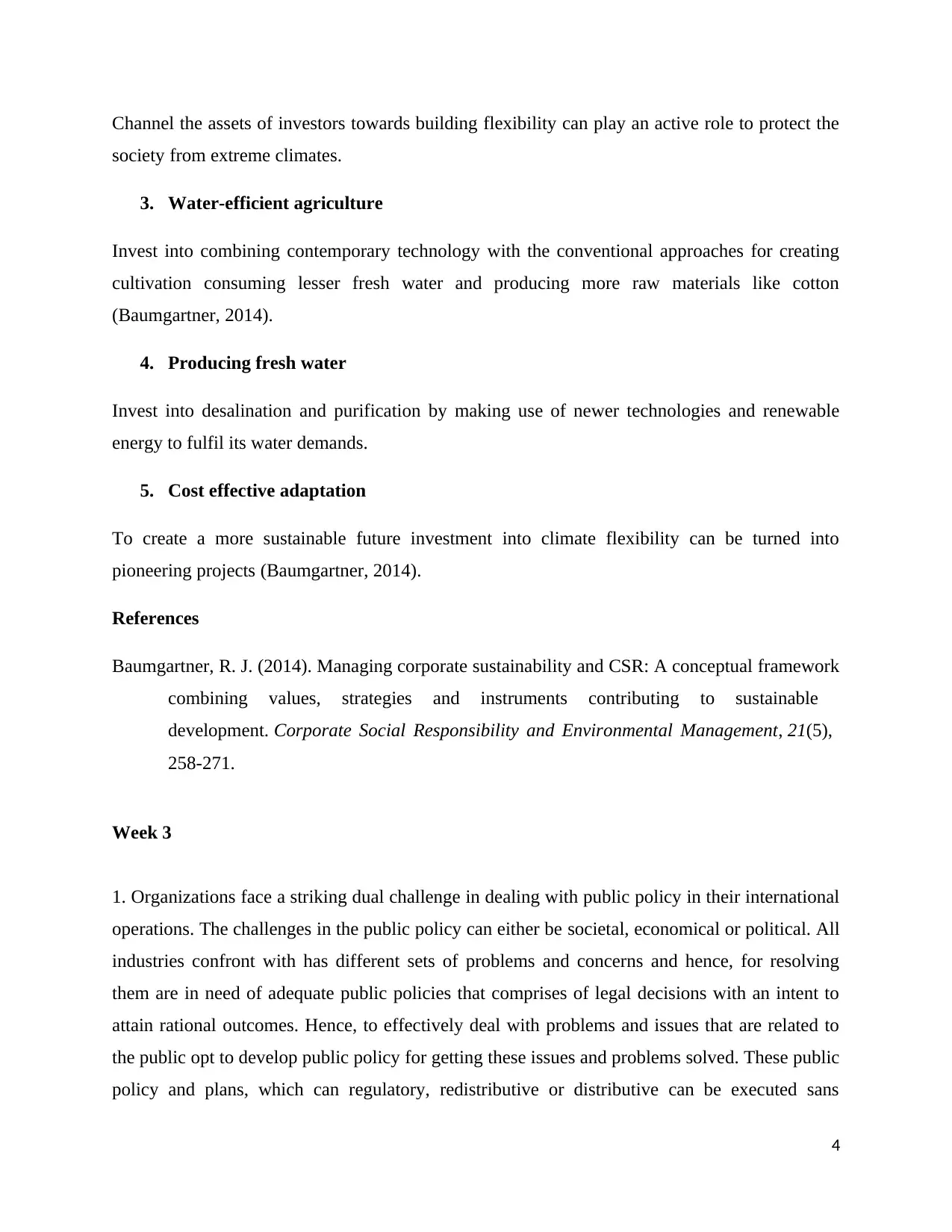
Channel the assets of investors towards building flexibility can play an active role to protect the
society from extreme climates.
3. Water-efficient agriculture
Invest into combining contemporary technology with the conventional approaches for creating
cultivation consuming lesser fresh water and producing more raw materials like cotton
(Baumgartner, 2014).
4. Producing fresh water
Invest into desalination and purification by making use of newer technologies and renewable
energy to fulfil its water demands.
5. Cost effective adaptation
To create a more sustainable future investment into climate flexibility can be turned into
pioneering projects (Baumgartner, 2014).
References
Baumgartner, R. J. (2014). Managing corporate sustainability and CSR: A conceptual framework
combining values, strategies and instruments contributing to sustainable
development. Corporate Social Responsibility and Environmental Management, 21(5),
258-271.
Week 3
1. Organizations face a striking dual challenge in dealing with public policy in their international
operations. The challenges in the public policy can either be societal, economical or political. All
industries confront with has different sets of problems and concerns and hence, for resolving
them are in need of adequate public policies that comprises of legal decisions with an intent to
attain rational outcomes. Hence, to effectively deal with problems and issues that are related to
the public opt to develop public policy for getting these issues and problems solved. These public
policy and plans, which can regulatory, redistributive or distributive can be executed sans
4
society from extreme climates.
3. Water-efficient agriculture
Invest into combining contemporary technology with the conventional approaches for creating
cultivation consuming lesser fresh water and producing more raw materials like cotton
(Baumgartner, 2014).
4. Producing fresh water
Invest into desalination and purification by making use of newer technologies and renewable
energy to fulfil its water demands.
5. Cost effective adaptation
To create a more sustainable future investment into climate flexibility can be turned into
pioneering projects (Baumgartner, 2014).
References
Baumgartner, R. J. (2014). Managing corporate sustainability and CSR: A conceptual framework
combining values, strategies and instruments contributing to sustainable
development. Corporate Social Responsibility and Environmental Management, 21(5),
258-271.
Week 3
1. Organizations face a striking dual challenge in dealing with public policy in their international
operations. The challenges in the public policy can either be societal, economical or political. All
industries confront with has different sets of problems and concerns and hence, for resolving
them are in need of adequate public policies that comprises of legal decisions with an intent to
attain rational outcomes. Hence, to effectively deal with problems and issues that are related to
the public opt to develop public policy for getting these issues and problems solved. These public
policy and plans, which can regulatory, redistributive or distributive can be executed sans
4
Paraphrase This Document
Need a fresh take? Get an instant paraphrase of this document with our AI Paraphraser
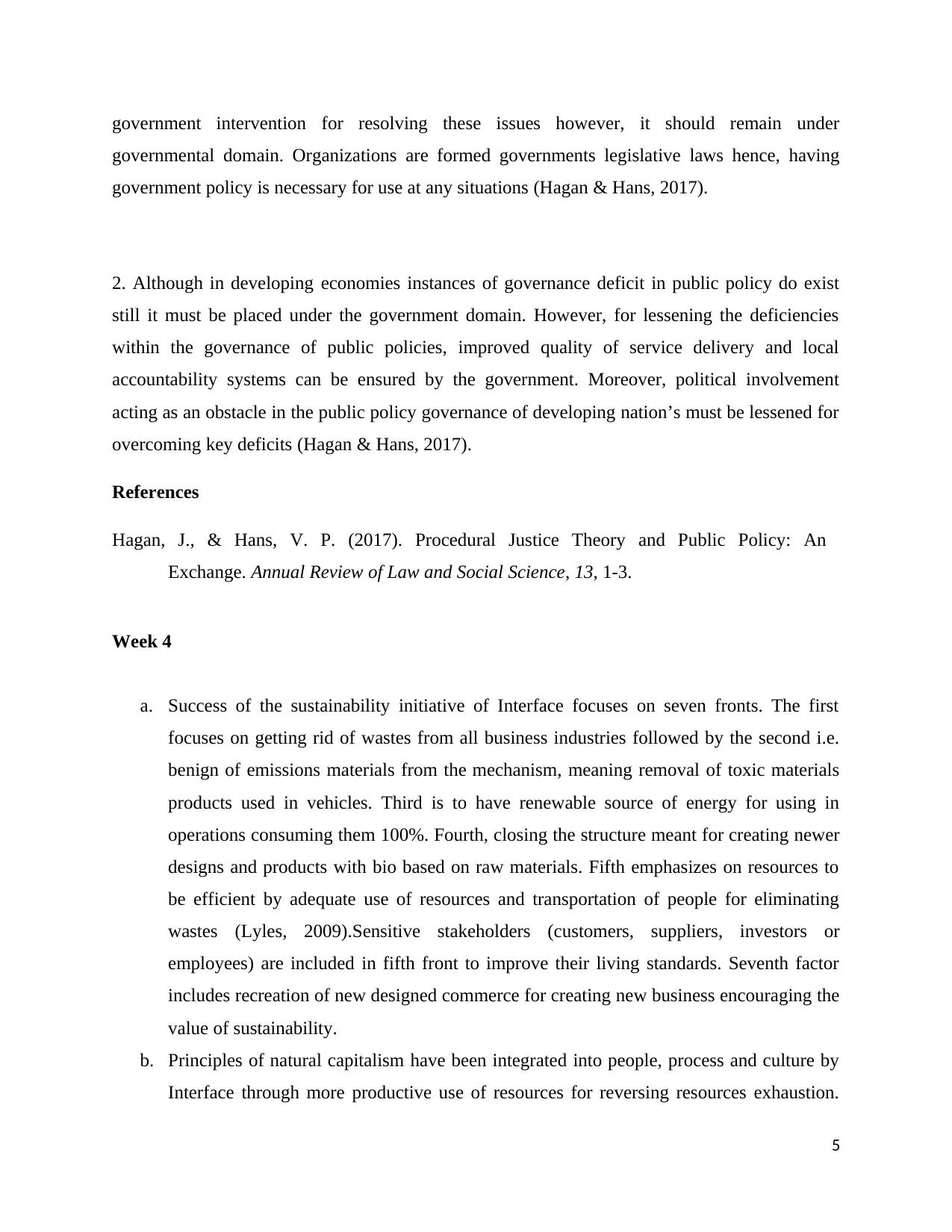
government intervention for resolving these issues however, it should remain under
governmental domain. Organizations are formed governments legislative laws hence, having
government policy is necessary for use at any situations (Hagan & Hans, 2017).
2. Although in developing economies instances of governance deficit in public policy do exist
still it must be placed under the government domain. However, for lessening the deficiencies
within the governance of public policies, improved quality of service delivery and local
accountability systems can be ensured by the government. Moreover, political involvement
acting as an obstacle in the public policy governance of developing nation’s must be lessened for
overcoming key deficits (Hagan & Hans, 2017).
References
Hagan, J., & Hans, V. P. (2017). Procedural Justice Theory and Public Policy: An
Exchange. Annual Review of Law and Social Science, 13, 1-3.
Week 4
a. Success of the sustainability initiative of Interface focuses on seven fronts. The first
focuses on getting rid of wastes from all business industries followed by the second i.e.
benign of emissions materials from the mechanism, meaning removal of toxic materials
products used in vehicles. Third is to have renewable source of energy for using in
operations consuming them 100%. Fourth, closing the structure meant for creating newer
designs and products with bio based on raw materials. Fifth emphasizes on resources to
be efficient by adequate use of resources and transportation of people for eliminating
wastes (Lyles, 2009).Sensitive stakeholders (customers, suppliers, investors or
employees) are included in fifth front to improve their living standards. Seventh factor
includes recreation of new designed commerce for creating new business encouraging the
value of sustainability.
b. Principles of natural capitalism have been integrated into people, process and culture by
Interface through more productive use of resources for reversing resources exhaustion.
5
governmental domain. Organizations are formed governments legislative laws hence, having
government policy is necessary for use at any situations (Hagan & Hans, 2017).
2. Although in developing economies instances of governance deficit in public policy do exist
still it must be placed under the government domain. However, for lessening the deficiencies
within the governance of public policies, improved quality of service delivery and local
accountability systems can be ensured by the government. Moreover, political involvement
acting as an obstacle in the public policy governance of developing nation’s must be lessened for
overcoming key deficits (Hagan & Hans, 2017).
References
Hagan, J., & Hans, V. P. (2017). Procedural Justice Theory and Public Policy: An
Exchange. Annual Review of Law and Social Science, 13, 1-3.
Week 4
a. Success of the sustainability initiative of Interface focuses on seven fronts. The first
focuses on getting rid of wastes from all business industries followed by the second i.e.
benign of emissions materials from the mechanism, meaning removal of toxic materials
products used in vehicles. Third is to have renewable source of energy for using in
operations consuming them 100%. Fourth, closing the structure meant for creating newer
designs and products with bio based on raw materials. Fifth emphasizes on resources to
be efficient by adequate use of resources and transportation of people for eliminating
wastes (Lyles, 2009).Sensitive stakeholders (customers, suppliers, investors or
employees) are included in fifth front to improve their living standards. Seventh factor
includes recreation of new designed commerce for creating new business encouraging the
value of sustainability.
b. Principles of natural capitalism have been integrated into people, process and culture by
Interface through more productive use of resources for reversing resources exhaustion.
5
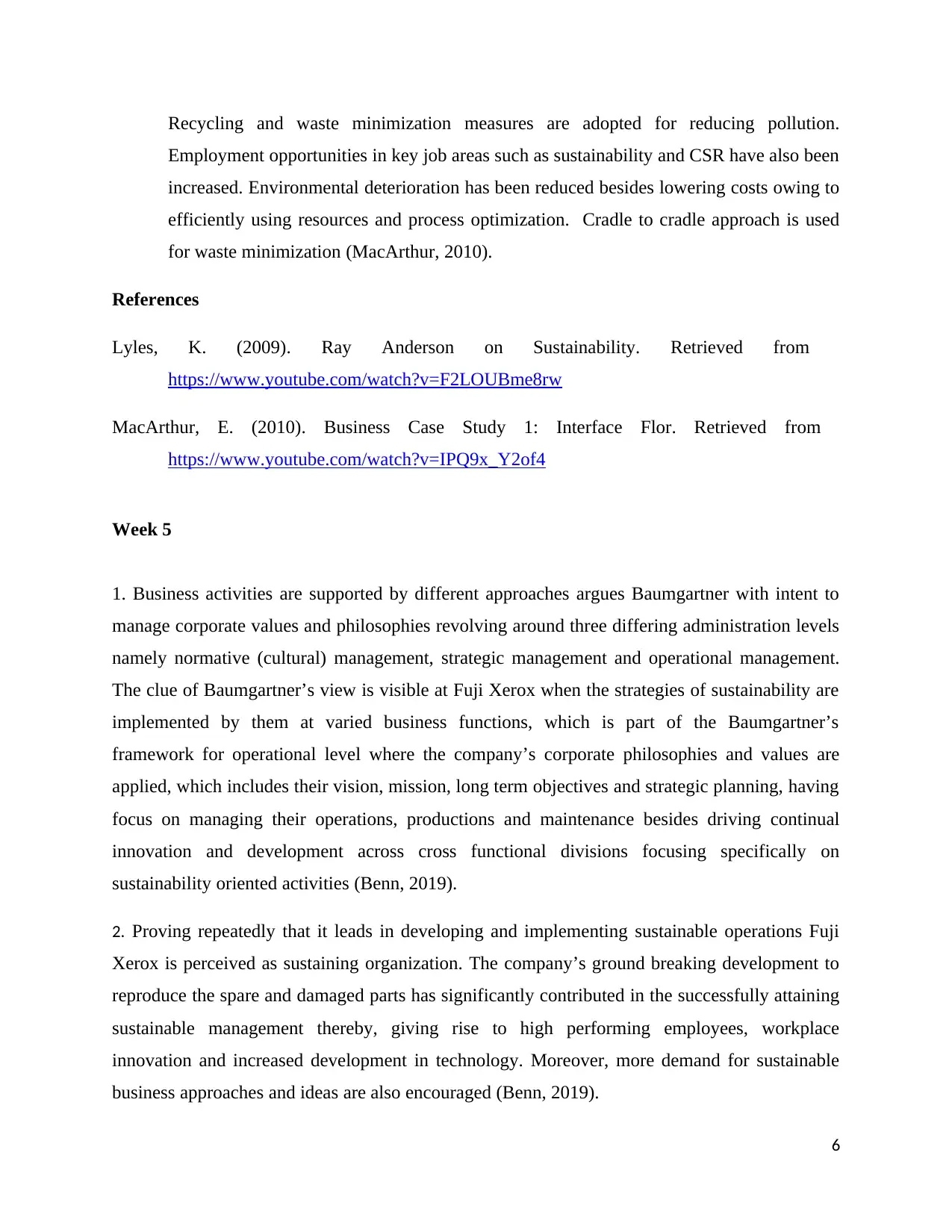
Recycling and waste minimization measures are adopted for reducing pollution.
Employment opportunities in key job areas such as sustainability and CSR have also been
increased. Environmental deterioration has been reduced besides lowering costs owing to
efficiently using resources and process optimization. Cradle to cradle approach is used
for waste minimization (MacArthur, 2010).
References
Lyles, K. (2009). Ray Anderson on Sustainability. Retrieved from
https://www.youtube.com/watch?v=F2LOUBme8rw
MacArthur, E. (2010). Business Case Study 1: Interface Flor. Retrieved from
https://www.youtube.com/watch?v=IPQ9x_Y2of4
Week 5
1. Business activities are supported by different approaches argues Baumgartner with intent to
manage corporate values and philosophies revolving around three differing administration levels
namely normative (cultural) management, strategic management and operational management.
The clue of Baumgartner’s view is visible at Fuji Xerox when the strategies of sustainability are
implemented by them at varied business functions, which is part of the Baumgartner’s
framework for operational level where the company’s corporate philosophies and values are
applied, which includes their vision, mission, long term objectives and strategic planning, having
focus on managing their operations, productions and maintenance besides driving continual
innovation and development across cross functional divisions focusing specifically on
sustainability oriented activities (Benn, 2019).
2. Proving repeatedly that it leads in developing and implementing sustainable operations Fuji
Xerox is perceived as sustaining organization. The company’s ground breaking development to
reproduce the spare and damaged parts has significantly contributed in the successfully attaining
sustainable management thereby, giving rise to high performing employees, workplace
innovation and increased development in technology. Moreover, more demand for sustainable
business approaches and ideas are also encouraged (Benn, 2019).
6
Employment opportunities in key job areas such as sustainability and CSR have also been
increased. Environmental deterioration has been reduced besides lowering costs owing to
efficiently using resources and process optimization. Cradle to cradle approach is used
for waste minimization (MacArthur, 2010).
References
Lyles, K. (2009). Ray Anderson on Sustainability. Retrieved from
https://www.youtube.com/watch?v=F2LOUBme8rw
MacArthur, E. (2010). Business Case Study 1: Interface Flor. Retrieved from
https://www.youtube.com/watch?v=IPQ9x_Y2of4
Week 5
1. Business activities are supported by different approaches argues Baumgartner with intent to
manage corporate values and philosophies revolving around three differing administration levels
namely normative (cultural) management, strategic management and operational management.
The clue of Baumgartner’s view is visible at Fuji Xerox when the strategies of sustainability are
implemented by them at varied business functions, which is part of the Baumgartner’s
framework for operational level where the company’s corporate philosophies and values are
applied, which includes their vision, mission, long term objectives and strategic planning, having
focus on managing their operations, productions and maintenance besides driving continual
innovation and development across cross functional divisions focusing specifically on
sustainability oriented activities (Benn, 2019).
2. Proving repeatedly that it leads in developing and implementing sustainable operations Fuji
Xerox is perceived as sustaining organization. The company’s ground breaking development to
reproduce the spare and damaged parts has significantly contributed in the successfully attaining
sustainable management thereby, giving rise to high performing employees, workplace
innovation and increased development in technology. Moreover, more demand for sustainable
business approaches and ideas are also encouraged (Benn, 2019).
6
⊘ This is a preview!⊘
Do you want full access?
Subscribe today to unlock all pages.

Trusted by 1+ million students worldwide
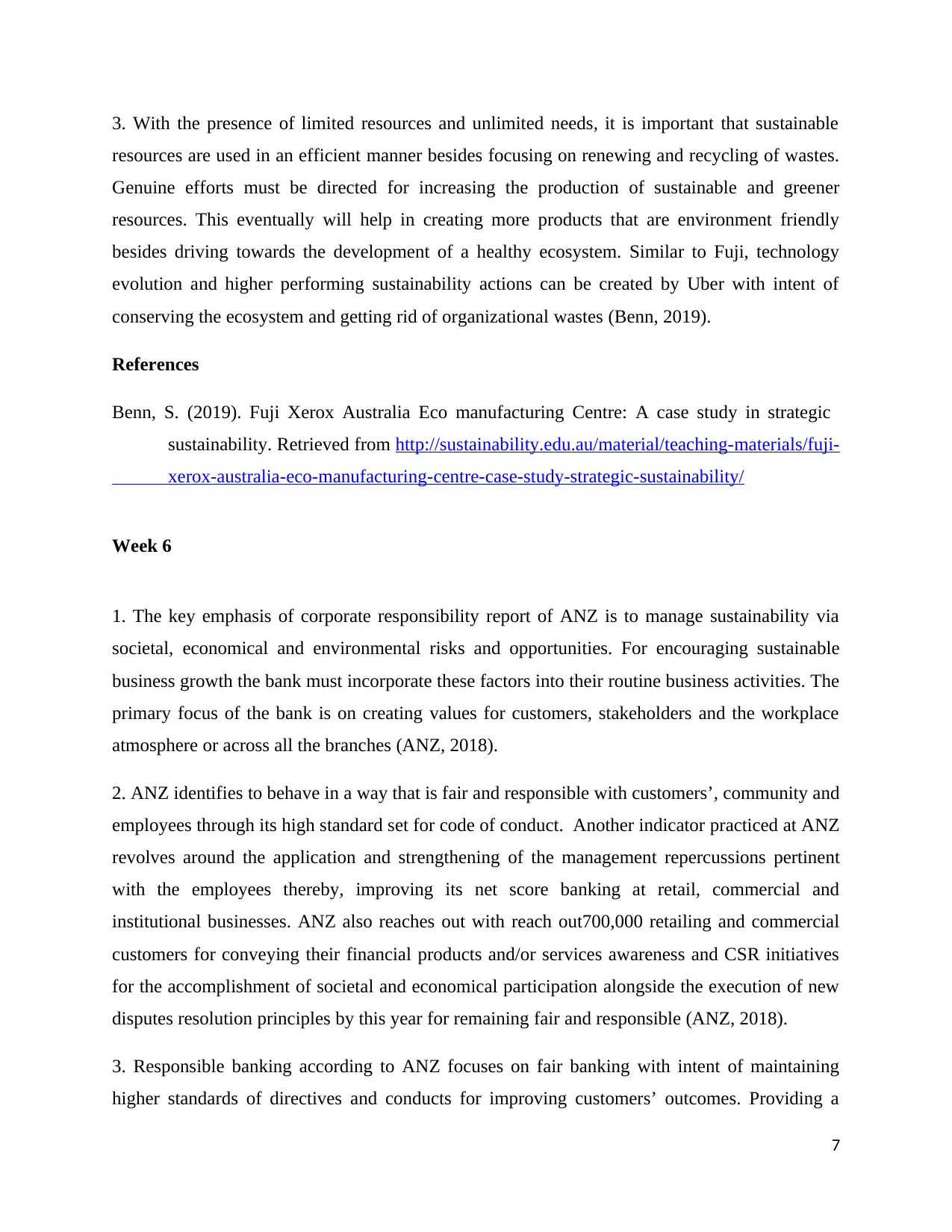
3. With the presence of limited resources and unlimited needs, it is important that sustainable
resources are used in an efficient manner besides focusing on renewing and recycling of wastes.
Genuine efforts must be directed for increasing the production of sustainable and greener
resources. This eventually will help in creating more products that are environment friendly
besides driving towards the development of a healthy ecosystem. Similar to Fuji, technology
evolution and higher performing sustainability actions can be created by Uber with intent of
conserving the ecosystem and getting rid of organizational wastes (Benn, 2019).
References
Benn, S. (2019). Fuji Xerox Australia Eco manufacturing Centre: A case study in strategic
sustainability. Retrieved from http://sustainability.edu.au/material/teaching-materials/fuji-
xerox-australia-eco-manufacturing-centre-case-study-strategic-sustainability/
Week 6
1. The key emphasis of corporate responsibility report of ANZ is to manage sustainability via
societal, economical and environmental risks and opportunities. For encouraging sustainable
business growth the bank must incorporate these factors into their routine business activities. The
primary focus of the bank is on creating values for customers, stakeholders and the workplace
atmosphere or across all the branches (ANZ, 2018).
2. ANZ identifies to behave in a way that is fair and responsible with customers’, community and
employees through its high standard set for code of conduct. Another indicator practiced at ANZ
revolves around the application and strengthening of the management repercussions pertinent
with the employees thereby, improving its net score banking at retail, commercial and
institutional businesses. ANZ also reaches out with reach out700,000 retailing and commercial
customers for conveying their financial products and/or services awareness and CSR initiatives
for the accomplishment of societal and economical participation alongside the execution of new
disputes resolution principles by this year for remaining fair and responsible (ANZ, 2018).
3. Responsible banking according to ANZ focuses on fair banking with intent of maintaining
higher standards of directives and conducts for improving customers’ outcomes. Providing a
7
resources are used in an efficient manner besides focusing on renewing and recycling of wastes.
Genuine efforts must be directed for increasing the production of sustainable and greener
resources. This eventually will help in creating more products that are environment friendly
besides driving towards the development of a healthy ecosystem. Similar to Fuji, technology
evolution and higher performing sustainability actions can be created by Uber with intent of
conserving the ecosystem and getting rid of organizational wastes (Benn, 2019).
References
Benn, S. (2019). Fuji Xerox Australia Eco manufacturing Centre: A case study in strategic
sustainability. Retrieved from http://sustainability.edu.au/material/teaching-materials/fuji-
xerox-australia-eco-manufacturing-centre-case-study-strategic-sustainability/
Week 6
1. The key emphasis of corporate responsibility report of ANZ is to manage sustainability via
societal, economical and environmental risks and opportunities. For encouraging sustainable
business growth the bank must incorporate these factors into their routine business activities. The
primary focus of the bank is on creating values for customers, stakeholders and the workplace
atmosphere or across all the branches (ANZ, 2018).
2. ANZ identifies to behave in a way that is fair and responsible with customers’, community and
employees through its high standard set for code of conduct. Another indicator practiced at ANZ
revolves around the application and strengthening of the management repercussions pertinent
with the employees thereby, improving its net score banking at retail, commercial and
institutional businesses. ANZ also reaches out with reach out700,000 retailing and commercial
customers for conveying their financial products and/or services awareness and CSR initiatives
for the accomplishment of societal and economical participation alongside the execution of new
disputes resolution principles by this year for remaining fair and responsible (ANZ, 2018).
3. Responsible banking according to ANZ focuses on fair banking with intent of maintaining
higher standards of directives and conducts for improving customers’ outcomes. Providing a
7
Paraphrase This Document
Need a fresh take? Get an instant paraphrase of this document with our AI Paraphraser
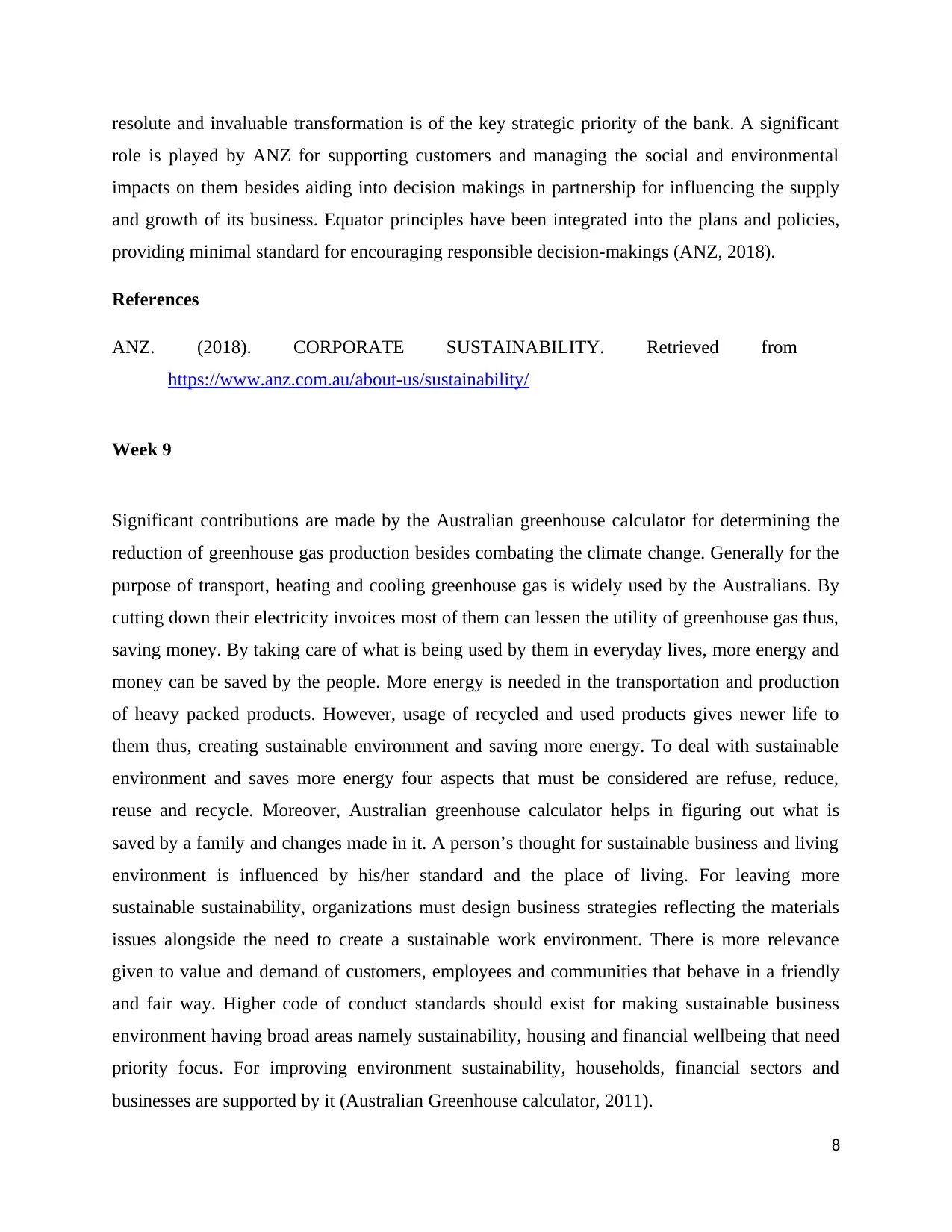
resolute and invaluable transformation is of the key strategic priority of the bank. A significant
role is played by ANZ for supporting customers and managing the social and environmental
impacts on them besides aiding into decision makings in partnership for influencing the supply
and growth of its business. Equator principles have been integrated into the plans and policies,
providing minimal standard for encouraging responsible decision-makings (ANZ, 2018).
References
ANZ. (2018). CORPORATE SUSTAINABILITY. Retrieved from
https://www.anz.com.au/about-us/sustainability/
Week 9
Significant contributions are made by the Australian greenhouse calculator for determining the
reduction of greenhouse gas production besides combating the climate change. Generally for the
purpose of transport, heating and cooling greenhouse gas is widely used by the Australians. By
cutting down their electricity invoices most of them can lessen the utility of greenhouse gas thus,
saving money. By taking care of what is being used by them in everyday lives, more energy and
money can be saved by the people. More energy is needed in the transportation and production
of heavy packed products. However, usage of recycled and used products gives newer life to
them thus, creating sustainable environment and saving more energy. To deal with sustainable
environment and saves more energy four aspects that must be considered are refuse, reduce,
reuse and recycle. Moreover, Australian greenhouse calculator helps in figuring out what is
saved by a family and changes made in it. A person’s thought for sustainable business and living
environment is influenced by his/her standard and the place of living. For leaving more
sustainable sustainability, organizations must design business strategies reflecting the materials
issues alongside the need to create a sustainable work environment. There is more relevance
given to value and demand of customers, employees and communities that behave in a friendly
and fair way. Higher code of conduct standards should exist for making sustainable business
environment having broad areas namely sustainability, housing and financial wellbeing that need
priority focus. For improving environment sustainability, households, financial sectors and
businesses are supported by it (Australian Greenhouse calculator, 2011).
8
role is played by ANZ for supporting customers and managing the social and environmental
impacts on them besides aiding into decision makings in partnership for influencing the supply
and growth of its business. Equator principles have been integrated into the plans and policies,
providing minimal standard for encouraging responsible decision-makings (ANZ, 2018).
References
ANZ. (2018). CORPORATE SUSTAINABILITY. Retrieved from
https://www.anz.com.au/about-us/sustainability/
Week 9
Significant contributions are made by the Australian greenhouse calculator for determining the
reduction of greenhouse gas production besides combating the climate change. Generally for the
purpose of transport, heating and cooling greenhouse gas is widely used by the Australians. By
cutting down their electricity invoices most of them can lessen the utility of greenhouse gas thus,
saving money. By taking care of what is being used by them in everyday lives, more energy and
money can be saved by the people. More energy is needed in the transportation and production
of heavy packed products. However, usage of recycled and used products gives newer life to
them thus, creating sustainable environment and saving more energy. To deal with sustainable
environment and saves more energy four aspects that must be considered are refuse, reduce,
reuse and recycle. Moreover, Australian greenhouse calculator helps in figuring out what is
saved by a family and changes made in it. A person’s thought for sustainable business and living
environment is influenced by his/her standard and the place of living. For leaving more
sustainable sustainability, organizations must design business strategies reflecting the materials
issues alongside the need to create a sustainable work environment. There is more relevance
given to value and demand of customers, employees and communities that behave in a friendly
and fair way. Higher code of conduct standards should exist for making sustainable business
environment having broad areas namely sustainability, housing and financial wellbeing that need
priority focus. For improving environment sustainability, households, financial sectors and
businesses are supported by it (Australian Greenhouse calculator, 2011).
8

References
Australian Greenhouse calculator. (2011). Animations. Retrieved from
https://apps.epa.vic.gov.au/AGC/animations.html#anim-greenhouse
Week 10
An imperative within the contemporary living of today is played by the supermarkets, which has
opened across all possible locations with intent to retail products at lower pricings resulting into
increased customers’ demands. For earning more profits through more revenue generation few
dominating supermarkets for example, Coles and Woolworths are open round-the- clock,
establishing the brand amongst the world’s top 20 retail stores. Based on the sales figures
decisions are made hence, what is good for them might be bad for customers. By promoting junk
food advantages are relatively gained by the supermarkets in terms of manufacturers’ money
paid and sales increase. Health issues of customers arise from the consumption of tobacco and
alcohol is the biggest concern for the supermarkets. Moreover, increased consumption of fat food
and soda has resulted into 63% people fighting with obesity and overweight problems in
Australia. Threat of regulation and negative public perceptions are the areas where the
supermarkets must take adequate actions. For dealing with these threats keeping in view the
health issues of the people, Woolworths had introduced a healthy lunch box thus, securing higher
market positioning. Supermarkets of late have changed their markets and transformed it into a
healthier one by focusing more on the health of the people eventually resulting into more
demand and customers thus, encouraging increased growth and market competition.
Supermarkets are likely to attain business expansion by placing more focus on sales of healthy
cum tasty food products besides making use of social campaigns to spread awareness about
being healthy (Cameron, 2014).
References
Cameron, A. (2014). How Supermarkets Flog You Junk Food To Maximise Profits. Retrieved
from https://www.lifehacker.com.au/2014/01/how-supermarkets-flog-you-junk-food-to-
maximise-profits/
9
Australian Greenhouse calculator. (2011). Animations. Retrieved from
https://apps.epa.vic.gov.au/AGC/animations.html#anim-greenhouse
Week 10
An imperative within the contemporary living of today is played by the supermarkets, which has
opened across all possible locations with intent to retail products at lower pricings resulting into
increased customers’ demands. For earning more profits through more revenue generation few
dominating supermarkets for example, Coles and Woolworths are open round-the- clock,
establishing the brand amongst the world’s top 20 retail stores. Based on the sales figures
decisions are made hence, what is good for them might be bad for customers. By promoting junk
food advantages are relatively gained by the supermarkets in terms of manufacturers’ money
paid and sales increase. Health issues of customers arise from the consumption of tobacco and
alcohol is the biggest concern for the supermarkets. Moreover, increased consumption of fat food
and soda has resulted into 63% people fighting with obesity and overweight problems in
Australia. Threat of regulation and negative public perceptions are the areas where the
supermarkets must take adequate actions. For dealing with these threats keeping in view the
health issues of the people, Woolworths had introduced a healthy lunch box thus, securing higher
market positioning. Supermarkets of late have changed their markets and transformed it into a
healthier one by focusing more on the health of the people eventually resulting into more
demand and customers thus, encouraging increased growth and market competition.
Supermarkets are likely to attain business expansion by placing more focus on sales of healthy
cum tasty food products besides making use of social campaigns to spread awareness about
being healthy (Cameron, 2014).
References
Cameron, A. (2014). How Supermarkets Flog You Junk Food To Maximise Profits. Retrieved
from https://www.lifehacker.com.au/2014/01/how-supermarkets-flog-you-junk-food-to-
maximise-profits/
9
⊘ This is a preview!⊘
Do you want full access?
Subscribe today to unlock all pages.

Trusted by 1+ million students worldwide

10
1 out of 10
Your All-in-One AI-Powered Toolkit for Academic Success.
+13062052269
info@desklib.com
Available 24*7 on WhatsApp / Email
![[object Object]](/_next/static/media/star-bottom.7253800d.svg)
Unlock your academic potential
Copyright © 2020–2025 A2Z Services. All Rights Reserved. Developed and managed by ZUCOL.
